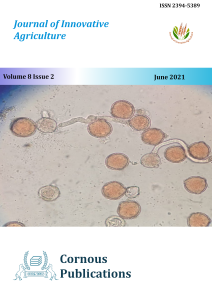
Journal of Innovative Agriculture
Peer Reviewed Open Access Journal
ISSN: 2394-5389 NAAS Rate: 4.05
Submit Manuscript
Peer Reviewed Open Access Journal
ISSN: 2394-5389 NAAS Rate: 4.05
Submit ManuscriptThe survey was conducted in Southwestern Ethiopia, to study the distribution and population dynamics of Coccinellidae predators associated with White Mango Scale (WMS). The identification of the predators was done by collecting infested mango leaves from the targeted fields. In all surveyed areas, three Chilocorus beetles spp. (Chilocorus spp. 1, 2, and 3) and one unknown beetle were identified feeding on all stages of WMS. The number of Chilocorus spp. 1 was higher compared with the other identified predators in all surveyed areas. Among the surveyed areas, East Wollega had the highest population of Chilocorus spp. 1. The peak population of the identified Coccinellidae predators and WMS varied from March to May depend on the species and areas. Overall, during the rainy and high temperature seasons, the number of both WMS and predators declined. The correlation study showed that the populations of the predators were positively correlated with weather factors and WMS, as prey factor. Altogether, the current study suggests that identified Coccinellidae Chilocorus spp. 1 was considered as the potential predator to control WMS. Therefore, future studies need to be focus on predacious efficacy, mass rearing and field release mechanism and compatibility with other management options.
Coccinellidae, predators, distribution, population dynamics, WMS
Abo-Shanab, A. (2012). Suppression white mango scale, Aulacaspis tubercularis Newstead (Hemiptera: Diaspididae) on mango trees in El-Beheira Governorate, Egypt. Egyptian Academic Journal of Biological Sciences, 5(3), 43-50.
Ayalew, G., Fekadu, A., & Sisay, B. (2015). Appearance and Chemical Control of white mango scale (Aulacaspis tubercularis) in Central Rift Valley. Science, Technology and Arts Research Journal, 4(2), 59-63.
Daneel, M., & Dreyer, S. (1998). Biological control of the mango scale, Aulacaspis tubercularis, in South Africa. Yearbook-South African Mango Growers' Association, 18, 52-55.
Daneel, M., & Joubert, P. (2006). Biological control of the mango scale Aulacaspis tubercularis Newstead (Coccidae: Diaspididae) by a parasitoid Aphytis chionaspis Ren (Hymenoptera: Aphelinidae). Paper presented at the VIII International Mango Symposium 820.
Djirata, O., Getu, E., & Ruth, K. G. (2017). Bionomics and Management of White Mango Scale, Aulacaspis tubercularis Newstead (Homoptera: Diaspididae) on Mango in Western Ethiopia, and Central and Eastern Kenya (Doctoral dissertation, PhD Dissertation, Addis Ababa University).
Erkiliç, L., & Uygun, N. (1995). Distribution, population fluctuations and natural enemies of the white peach scale, Pseudaulacaspis pentagona (Targioni-Tozzetti)(Homoptera: Diaspididae) in the East Mediterranean region of Turkey. Israel Journal of Entomology, 29, 191-198.
Greathead, D. J. (1997). 1.3. 3 Crawler behaviour and dispersal. In World crop pests (Vol. 7, pp. 339-342): Elsevier.
Greathead, D. J., & Pope, R.D. (1977). Studies on the biology and taxonomy of some Chilocorus spp.(Coleoptera: Coccinellidae) preying on Aulacaspis spp.(Hemiptera: Diaspididae) in East Africa, with the description of a new species. Bulletin of Entomological research, 67(2), 259-270.
Hajek, A.E., & St. Leger, R.J. (1994). Interactions between fungal pathogens and insect hosts. Annual review of entomology, 39(1), 293-322.
Honja, T. (2014). Review of mango value chain in Ethiopia. Journal of Biology, Agriculture and Healthcare, 4(25), 230-239.
Karuppaiah, V., & Sujayanad, G. (2012). Impact of climate change on population dynamics of insect pests.
Labuschagne, T., Van Hamburg, H., & Froneman, I. (1995). Population dynamics of the mango scale, Aulacaspis tubercularis (Newstead)(Coccoidea: Diaspididae), in South Africa. Israel Journal of Entomology, 29, 207-217.
Mohammed Dawd, B. H. G., Lemma Ayele, KonjitFeleke, Seyoum Hailemariam and Teshome Burka (2012). WMS: A new insect pest of mango in western Ethiopia. Proceedings of the 3rd biennial conference of Ethiopian Horticultural science Society.
Neuenschwander, P., & Markham, R. (2001). Biological control in Africa and its possible effects on biodiversity. In Evaluating indirect ecological effects of biological control. Key papers from the symposium'Indirect ecological effects in biological control', Montpellier, France, 17-20 October 1999 (pp. 127-146). Wallingford UK: CABI Publishing.
Omkar, & Pervez, A. (2003). Ecology and biocontrol potential of a scale-predator, Chilocorus nigritus. Biocontrol Science and Technology, 13(4), 379-390.
Rezk, M. A. A. (2009). Biological control of certain scale insects and mealybugs infesting certain fruit trees.
Temesgen, F. (2014). White mango scale, Aulacaspis tubercularis, distribution and severity status in East and West Wolega zone, Western Ethiopia. Science, Technology and Arts Research Journal, 3(3), 1-10.
Wuensch, K. L. (1996). Straightforward Statistic For the Behavioral Sciences. Journal of the American Statistical Association, 91(436), 1750.
Zeki, C., Ülgentürk, S., Noyes, J., & Kaydan, M.B. (2004). Natural Enemies of Coccoidea (Hemiptera) on Orchard Trees and the Neighbouring Areas Plants in Afyon, Ankara, Burdur Isparta Provinces, Turkey. Report on ISSIS–X and related activities, 361-372.
